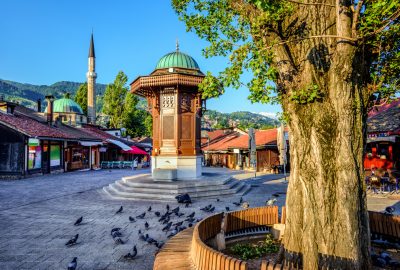Sarajevo is where the east meets the west. I am aware it’s one of the most overused lines in the history of travel blogs. A huge cliché, but a very true one in this case. Sarajevo is divided into two parts, the east one and the west one. There’s an inscription on one of the streets marking the spot where the two meet. The east side was developed by the Ottoman Empire in the 14th century. This “cradle” of Sarajevo has a distinct oriental aura to it. People even call it the Jerusalem of Europe. It’s not only the architecture but because of all the religions that coexist here. You’ll see synagogues, Orthodox churches, and several mosques. Gazi Husrev-beg was the governor responsible for building most of the Old Town. The main mosque in Bosnia and Herzegovina is named after that man. He shaped Sarajevo into the most civilized European city of the 16th century. He invested a fortune into educating the masses in religious schools teaching Sufism. It’s the mystical branch of Islam, kind of what the Qabalah is for Judaism. Sarajevo was the second most powerful city in the region after Istanbul. That was a high ceiling to surpass. The Baščaršija predates even Gazi Husrev-beg. This beautiful oriental marketplace remains the core of the Ottoman Sarajevo to this day. Local craftsmen manufacture the best souvenirs you can find in the city. The Baščaršija Square is a popular meeting point for tourists. They usually gather around the Sebilj Fountain, one of Sarajevo’s main landmarks. You know the drill: toss a coin in and you’ll eventually come back. Funny how so many fountains, all over the world share the same superstition.

Latin bridge over river Miljacka in Sarajevo: the murder of Archduke Franz Ferdinand took place here; the event that marked the beginning of the First World War
The western part of Sarajevo is thoroughly European. The Ottoman Empire was practically no more by the end of the 19th century. Austria-Hungary occupied Bosnian territories. The Treaty of Berlin was signed in 1878. That meant that Sarajevo officially became a part of the empire. It’s a short summary; there obviously were fights, bloodshed and executions along the way. Changes were in order and westernization of Sarajevo commenced. Rapidly. The Sacred Heart Cathedral, the largest in Bosnia and Herzegovina, was built in only 3 years. The City Hall was a monumental project that was supposed to become a symbol of power of the new rulers. Everything went smoothly until they came across one guy. He didn’t want to move his house to make space for the construction. He demanded them to move his house, brick by brick, to the other side of the river. And they did. The regime couldn’t have been that bad, right? They could’ve just shot him in the head. “The House of Spite” stands vis-à-vis the City Hall to this day. It’s been converted into a restaurant serving delicious Bosnian food. Things were going great for Sarajevo until shit hit the fan in 1914. A Serbian nationalist assassinated Archduke Franz Ferdinand and his wife Sophie, while visiting the city. It is known as THE event that triggered the First World War. But I dare to say that when the nineteen-year-old Bosnian Serb Gavrilo Princip who fired the shots would have stayed in bed on that historical June 28, 1914 the “Great War” would have started soon anyway. The world was in such turmoil those days that it was just a matter of time until it went off. I’m not a historian though, you can learn more about all that at Museum of the Assassination of Franz Ferdinand. It stands right in the spot where it all happened.

On Sarajevo's Bascarsija square there is a wooden fountain Sebilj in a pseudo-Moorish style; according to legend, whoever drinks from the fountain will definitely return to Sarajevo
The war lasted for 5 years and resulted in Sarajevo becoming a part of Yugoslavia. Fast-forward a few decades and the Second World War. Bosnia and Herzegovina breaks up with Yugoslavia and Yugoslavia doesn’t like it. Sarajevo became the site of the longest city siege in history of modern warfare. Over four years of almost constant artillery fire. The damage done was unthinkable. You’ll notice the Sarajevo Roses, these are the holes made by the mortar shells. People decided to fill them with red resin to commemorate those tragic events. Visit the Sarajevo Tunnel Museum to dig deeper into the history of the Bosnian War. Horrible pun. It was used to get supplies in and people out during the siege of Sarajevo. Only a tiny part of it is safe enough for tourists to explore, but it sure leaves an impression. If you want to learn more about the siege of Sarajevo I strongly recommend you to watch the movie “Welcome to Sarajevo”, Michael Winterbottom's critically-acclaimed war drama. It’s nothing less than a masterpiece with a brilliant Woody Harrelson as cynical war journalist and a magnificent soundtrack. Watching when people flee through the tunnel under heavy gun and grenade fire to the tunes of “I Wanna Be Adored” of The Stone Roses still gives me goose pickles. And the scene when Bosnian Serbian soldiers round up children and other passengers of a bus is nerve breaking. All this war talk makes Sarajevo sound like a gloomy, depressing place. It’s everything but that. I believe it’s one of those cities everyone should visit at least once. Not for long though, a weekend is enough.



No one commented yet. Be the first.